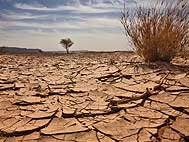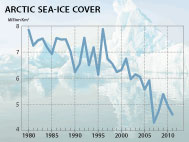| SEARCH |
-

Nov 17, 2015
Reflections on a three-decade legacy
The International Geosphere-Biosphere Programme (IGBP) will come to a close at t...
-
Nov 17, 2015
Use of and access to content on this website
Text and images produced by IGBP in house are free to use with appropriate credi...
-
Nov 12, 2015
Bella Gaia performance and panel discussion to mark IGBP's closure
A musical performance by Bella Gaia will celebrate the achievements and legacy o...
-

Towards Future Earth:
evolution or revolution?
During its three decades of existence, the International Geosphere-Biosphere Pro...
-
A personal note on IGBP and the social sciences
Humans are an integral component of the Earth system as conceptualised by IGBP. João Morais recalls key milestones in IGBP’s engagement with the social sciences and offers some words of advice for Future Earth.
-
IGBP and Earth observation:
a co-evolution
The iconic images of Earth beamed back by the earliest spacecraft helped to galvanise interest in our planet’s environment. The subsequent evolution and development of satellites for Earth observation has been intricately linked with that of IGBP and other global-change research programmes, write Jack Kaye and Cat Downy .
-
Deltas at risk
Around 500 million people worldwide live on deltas, but many of the world's deltas are sinking due ...
-
Climate change: the state of the science
A new data visualization released on the first day of the plenary negotiations at the UNFCCC’s clima...
-
Climate Change:
the State of the Science
Videos now online from the Stockholm public forum to mark the launch of the IPCC's climate report, 2...

Closing the global budget for CO2
The Global Carbon Project is an IGBP joint project with DIVERSITAS, the International Human Dimensions Programme and the World Climate Research Programme.
www.globalcarbonproject.org/
The available scientific knowledge tells us that the two large carbon reservoirs – the terrestrial biosphere and the oceans – have taken up the excess CO2 in approximately equal proportions. However these CO2 “sinks” are not fixed, in fact they are highly variable and respond to elevated atmospheric CO2 levels and changes in the climate. To account fully for all the CO2 emitted, we need to know the size of the land and ocean CO2 sinks and their evolution in time. And we need to know this with an accuracy that is higher than the uncertainty in CO2 emissions themselves. Full accounting of CO2 emissions is a necessity if we are to monitor the transition from a CO2-intensive to a low CO2 economy. Unaccounted CO2 emissions open the door to all kinds of abuses, from inaccurate accounting and declaration of countries’ emissions to misleading demands for carbon credits associated with Clean Development Mechanisms and geoengineering options.
Can we quantify the global CO2 sinks to such accuracy? To answer this question, we (Le Quéré et al. 2009) have put together a global CO2 budget of all the major sources and sinks of CO2 for every year from 1959 to 2008 (Figure 1). The aim is to provide information on the year-to-year changes in all aspects of the global CO2 budget, and to identify the drivers of variability and trends. We used economic data to estimate CO2 emissions from fossil-fuel combustion and land-use change. Atmospheric CO2 was measured directly from a network of around 100 stations. We quantified the evolution of the land and ocean CO2 sinks with the help of models. All models included key processes like plant productivity and respiration on land and circulation, chemical reactions and biological productivity in the ocean. All models were forced by increasing atmospheric CO2 and the meteorological conditions corresponding to the time period of study. To minimise the errors, we used the mean of all models and estimated error using model spread.



What were we looking for? The study compared estimated global CO2 emissions from fossil-fuel use and land-use change with the annual sum of our best estimate of CO2 increase in the atmosphere, ocean and land during this period (Figure 2). Of course, in theory the undulations of the two lines on the graph should be identical, but they are not: emissions grew steadily but there is considerable annual variability in the estimated CO2 stored in the atmosphere, ocean and land. So current knowledge does not account for all emitted CO2 .
Known problems in the CO2 budget explain most of the mismatch. For instance, in the 1970s, it seems there was more additional CO2 in the system than emissions indicate. We know that La Niña-like conditions led to unusual cool, wet conditions prevailing in the tropics throughout the 1970s causing more carbon to move to the land sink. The models overestimated the land-CO2 uptake in response to these conditions.
Similarly, the massive Mount Pinatubo volcanic eruption in 1991, which affected climate globally by injecting large volumes of small particles into the upper atmosphere, helps explain the missing CO2 in the early 1990s. The land models did not account for the increase in available light in the vegetation canopy from enhanced diffusion during and after the eruption.
Finally, the excess CO2 of the late 1990s appears to be partly a signature of political incentives to clear land in Indonesia that took advantage of the ongoing drought conditions.




One interesting result coming out of this analysis was that the trends in accounted CO2 matched well the trends in emitted CO2 – both rising at the same rate. This suggests that the processes represented in the models, such as the timescale of penetration of CO2 in the ocean and the turnover time of soil carbon, are correct to a first order. We can use information on the trends to keep track of the partitioning of the emitted CO2 between the atmosphere and the sinks. In particular, the fraction of the total CO2 emissions that remained in the atmosphere – the airborne fraction – is a good indicator of the capacity of the land and ocean sinks to absorb excess CO2 from the atmosphere. If the sinks weaken, more CO2 will remain in the atmosphere and amplify global warming.
Our analysis of the trend in airborne fraction from this global CO2 budget shows a likely positive trend of 0.3 percent per year, with a 90 percent probability the trend is above background variability and additional uncertainty due to poorly quantified land-use CO2 emissions. The models reproduce such a trend and suggest it is a response of the land and ocean sinks to climate variability and climate change for the past 50 years. If the model results are correct in how they represent the processes that reproduced past trends, this supports the existence of a positive feedback between climate and the carbon cycle that was predicted by many carbon-cycle models.
The range of model results is representative of the uncertainty in the known processes. The range of results is smaller than the uncertainty in emissions, which supports the possibility that full accounting of emitted CO2 is possible, even with existing models. However, to reach such a state requires major improvements in models’ year-to-year estimation of CO2 sinks.
The land models could be improved right away by including the known missing processes. The land and ocean models could also be improved further if the mismatch with observations can be constrained not only globally, but also spatially. Regional information is available from direct measurements in the ocean, and from inverse methods that provide information on the regional variability in the CO2 fluxes.
We could achieve further improvements if the sinks could be quantified directly from observations. For the ocean, this may be possible with increased data coverage and improved analysis tools. There is little prospect of estimating the land CO2 sink directly, and thus it will always have to rely on models. Model validation in this context becomes crucial as it ensures the quality of the model estimates.
Economic slump
In the past decade, CO2 emissions increased at a rate of three percent per year. The emissions are projected to decrease in 2009 in response to the global economic downturn. However this decrease should only bring the global emissions down to their 2007 levels. The key to decreasing global emissions in the long term is to decouple energy use from wealth. With the large reorganisation of the world’s energy system that is required to stabilise CO2 in the atmosphere, the global change in CO2 emissions will be closely scrutinised in the future. There would be enormous benefits to society if the world’s scientific community pulls its expertise together to provide information to account for all the CO2 emitted to the atmosphere. This could assist a peaceful transition to a different economy, but also provide an early warning of how the natural carbon cycle responds to CO2, climate and other environmental changes

Le Quéré C et al. (2009) Trends in the sources and sinks of carbon dioxide.
Nature Geoscience doi:10.1038/ngeo689.
IGBP closed at the end of 2015. This website is no longer updated.
-

Global Change Magazine No. 84
This final issue of the magazine takes stock of IGBP’s scientific and institutional accomplishments as well as its contributions to policy and capacity building. It features interviews of several past...
-

Global Change Magazine No. 83
This issue features a special section on carbon. You can read about peak greenhouse-gas emissions in China, the mitigation of black carbon emissions and the effect of the 2010-2011 La Niña event on gl...
-
INTERGOVERNMENTAL PANEL ON CLIMATE CHANGE:
How green is my future?
UN panel foresees big growth in renewable energy, but policies will dictate just how big.
-
UK:
'The Anthropocene: a new epoch of geological time?'
Royal Society, Philosphical Transactions A




















